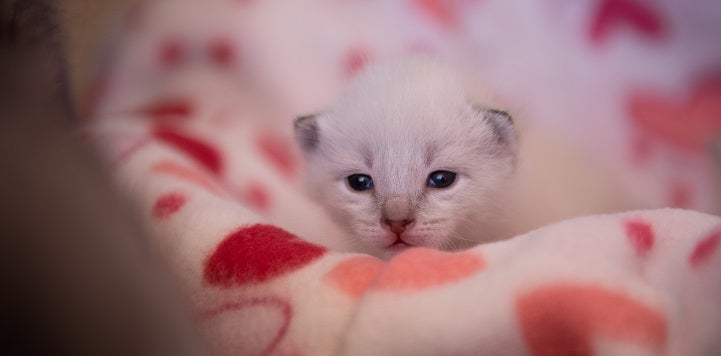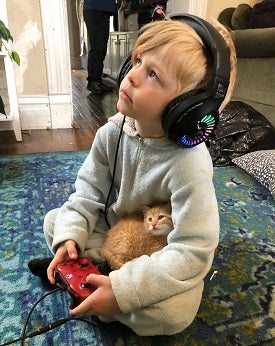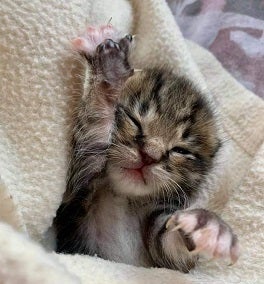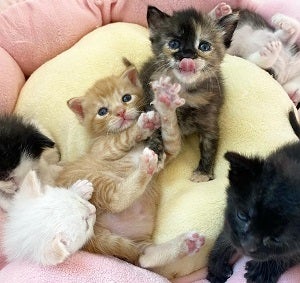
Kitten programs 2.0 part 2: Bringing up (a neonatal) baby
Last week’s program spotlight reviewed some medical practices that are helping save more neonatal kittens. But a kitten program that caters to orphans in the first weeks of their lives doesn’t only need to focus on good healthcare. Anyone providing care to a neonates also needs to pay attention to the psychological needs of both felines and human alike so that everyone can come away from the experience healthy in mind and in body.
Talk about the tough stuff
Caring for orphans is tough work that can take an emotional toll. Waking up at all hours to feed often uncooperative babies, worrying that every subtle change is indicative of a horrible disease and just cleaning up all the poop is stressful and exhausting. The most difficult aspect of caring for very young kittens, however, involves coping with the likelihood that they will not survive even with the best care.
“You have to get comfortable talking to fosters about mortality rates, which I think is the one thing that really keeps people from fostering neonates,” says Esther Neonatal Kitten Alliance (Kitten Alliance) founder and executive director Andee Bingham. Kitten Alliance has a mortality rate of 30%, which seems high until you consider that the program mostly takes in just-born, critically ill and/or injured babies.
Such mortality rates are not limited to kittens raised by rescues or fosters either, according to Heather Kennedy, DVM, director of feline operations at Kansas City Pet Project (KCPP).
“There are several small studies looking at mortality rate of purebred kittens in catteries prior to weaning and it’s not much lower than we see in the shelter,” she says. “As an open admission shelter, we also typically take in kittens in the worst condition, and our mortality rate was around 20%.”
“It’s awful to lose kittens, especially ones that you've put so much work into by feeding them every two or three hours,” Andee says. “But it's important for people to understand that without fosters, 100% of these kittens would die.”
Give credit where credit is due
Heather and Erin Katribe, DVM, medical director for Best Friends Animal Society, strongly agree that fosters are the true lifeline for neonates.

“Sometimes I think fosters believe the shelter or clinic staff, just don’t care because we send kittens to foster that die; they don’t think we do enough for them,” Heather says. “We try to explain that the very best thing we can do for them is send them to foster for individual attention.
“In most cases, there’s no special care that we can provide at the shelter or in the clinic that makes a neonatal kitten more likely to survive in our care as opposed to a foster home,” she continues. “Fosters are literally the only ones capable of saving these lives if they can be saved. Mom cat is almost always best, foster home is second best, and the shelter is rarely the best.”
“It’s difficult for people to make themselves vulnerable and do this difficult thing,” says Hannah Shaw, “Kitten Lady” and founder of Orphan Kitten Club, whose Mightycat grant program supports organizations wishing to start programs for kittens under the age of 12 weeks. Funds are only available to the organization’s partners, who can apply for funding from $2,500 for individual cases to $25,000 for innovative programming.
“As a foster who has lost kittens, it always meant a lot when I got a card that said, ‘It’s OK, we love you and we have gone through this, too’,” Hannah says. “You need to hear that when you go through something hard, and this work is hard. You need to take care of those people and make sure they have a good experience.”
Build a well-oiled machine
Especially with the trend moving away from brick-and-mortar programs, there is some discussion about whether kitten programs can operate solely on volunteer labor as opposed to hiring staff. While having a solid contingent of fosters is critical, even your most seasoned volunteer can benefit from staff support.
“You need someone on your staff who understands neonates and can oversee a program because those fosters really need mentorship and support,” says Hannah.

Volunteers sometimes will provide such support, but the fluctuating nature of volunteerism means programs are at risk of suffering from inconsistency. A well-trained staff member, on the other hand, can provide needed supplies, collect data, arrange for vaccinations and spay/neuter appointments and answer questions about the husbandry and health needs of neonates. They are also invaluable when emergencies come up.
“Time is of the essence with neonatal kittens, so you have to have a plan for triage and quick intervention,” Hannah says. ““A goopy eye is not going to kill them in the next 24 hours, but a kitten who is agonal breathing is an emergency.”
While volunteer program managers might not have the power to arrange for immediate care at predetermined vet clinics, staff can make that happen. And that’s another important component of supporting the needs of foster parents.
“If it's Friday and a kitten is in critical shape, you can’t tell the foster parent to bring them in on Monday because the kitten will be dead by then,” Hannah says. “And you will end up burning out those who have such a heartbreaking experience that they never want to do it again.”
Monitor the milestones
It’s easy to be consumed by the tasks of weighing neonates, taking their temperatures frequently and charting what their poop looks like. But if foster parents aren’t also monitoring whether a three-week-old kitten is starting to walk and explore his surroundings, the program might not be set up to create the most well-rounded cats.

In addition to knowing what weekly milestones to be looking for, fosters should be exposing kittens to a wide variety of people and experiences as they get older. There is a small window in which to socialize kittens – typically considered under seven weeks, though there is a genetic component of behavior that creates some individual variability.
“Don’t just bring the kittens home and watch them play. After their eyes open, they're ready for you to introduce them to the world one novel experience at a time,” Heather says. “I think we've reached the saturation point of cats living under people’s beds because we attempted to socialize them after the sensitive period. I see more of a focus on working with neonatal kittens so that they become more confident and less stressed adults.”
Hannah’s advice on how to bring up a neonatal kitten successfully is to take pointers from a mom cat.
“No one can show you how to care for a baby better than a mom cat,” Hannah says. “That includes giving them baths. A lot of people don’t want to bathe kittens, but moms keep their babies sparkly clean. In fact, when you don’t keep orphans clean, you send them the message that they are being neglected. That’s stressful for them.”
Always balance risk with reward
It’s fair to say that cat people are split on whether single kittens should be put together, added into a group of kittens or allowed to nurse on a mom. On the positive side, these are opportunities for single kittens to also gain important social skills from their peers.
“When we get a kitten who is a singleton, we try to find another kitten or kittens of the same age as quickly as possible,” Hannah says. “We don’t introduce them to one another right away, but we do want to start the 14-day quarantine process at the same time.
“Last year we were able to put two orphans together – Mr. Peep and Ruthie – and they became BFFs,” she adds. “They spent their formative weeks for behavioral development together and they're like angels.”

Being around other kittens can also help singletons from becoming, for lack of a better phrase, “a little weird.” (Though cat people are, again, divided on whether single bottle babies are kinda crazy.)
“I’ve definitely seen it, and I think that's a really great example of a place where operations, animal care, adoption staff and the vet team can collaborate and talk through options,” says Erin Katribe, DVM, MS, medical director for Best Friends Animal Society. “I just adopted out my singleton foster. We were working with him, but he has lots of problems. Had he been with other kittens, who knows how he would have turned out but it’s less likely he would have been a mess.”
If you have an orphan who needs to be fed but no one can do it, putting them with a nursing mom is the only chance they might have for survival.
“We call that ‘cowbirding,’ because cowbirds try to get other birds to raise their young,” Heather says, using a term coined by one of her mentors, Cristie Kumaya of Humane Society of Silicon Valley. “There is always the possibility for disease transmission or the possibility that the mom won't accept the kitten, but I see no problem with trying it if you are comfortable doing so.”
Those who are strongly opposed to such practices tend to feel the risk is not worth it. But just like many of the decisions we make in sheltering, choices are always circumstantial.
“I was in a shelter years ago whose policy was to immediately euthanize kittens not old enough to eat on their own,” Hannah says. “An orphan came in while I was standing there and since there was a mom nearby, I grabbed the baby and stuck her in with mom.
“But I have no idea if either one of them had been exposed to something awful,” she adds. “I don't need to have it happen here to know how upset I would be if I introduce two kittens and one of them had panleukopenia and gave it to the other one.”
“If you are asking if it’s a best practice or recommended, the answer is no,” Erin says. “It’s really easy to get burned by an outbreak of panleukopenia and then have that one situation stick in your brain forever.
“I think it’s always worth keeping detailed data and re-examining your policies,” she continues. “You’ll remember the one awful case, but you won’t remember the 500 kittens that you were able to save.”
“You’re taking a risk no matter what you do,” adds Heather. “Whether that’s mixing singletons, putting them with a mom cat or introducing them to your own cats, you just have to know what the risks are and if you are willing to take them. We’re all just doing the best we can to save as many lives as possible.”
Last week we talked about the practice of tube-feeding neonates. If you want to add this skill to your repertoire, check out KCPP’s video on the subject.

Liz Finch
Senior Writer
Best Friends Network
If you enjoyed this program spotlight, you can find our complete catalog of spotlights here.